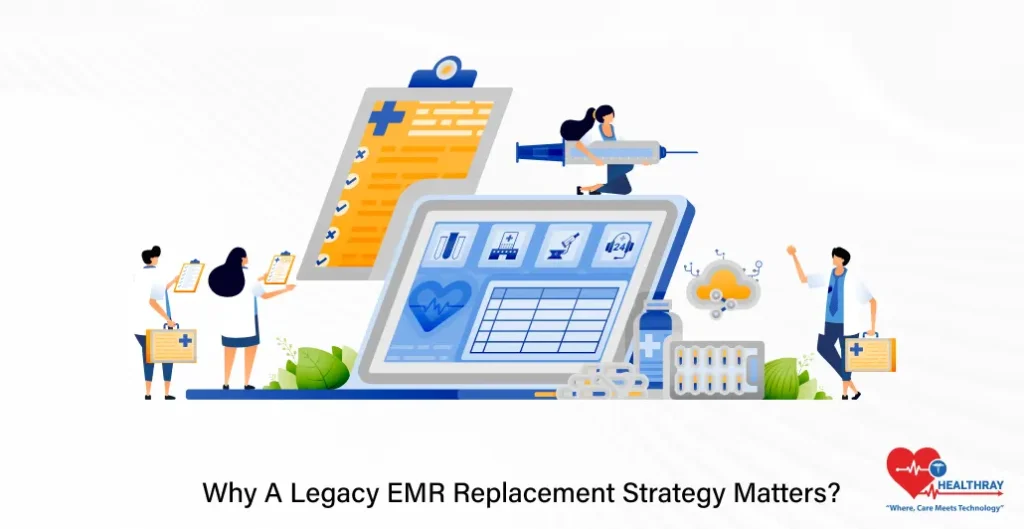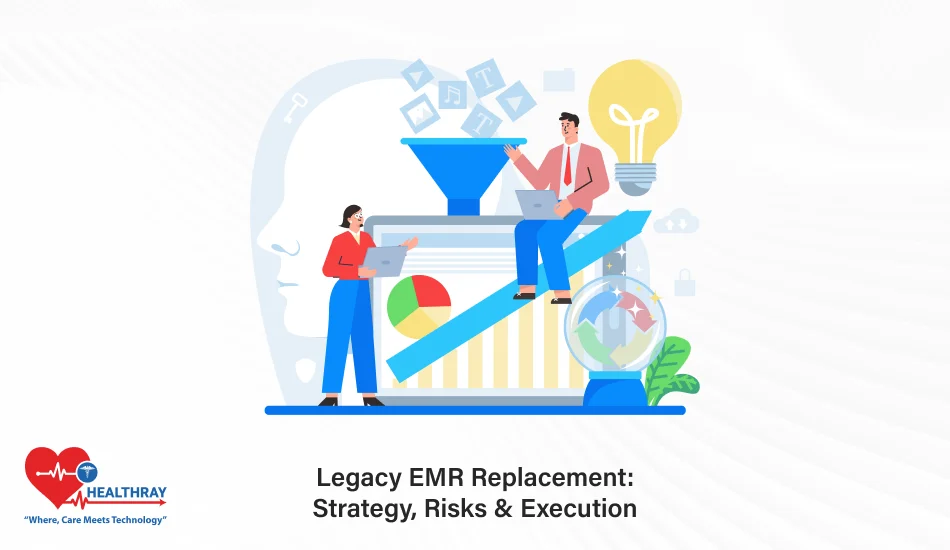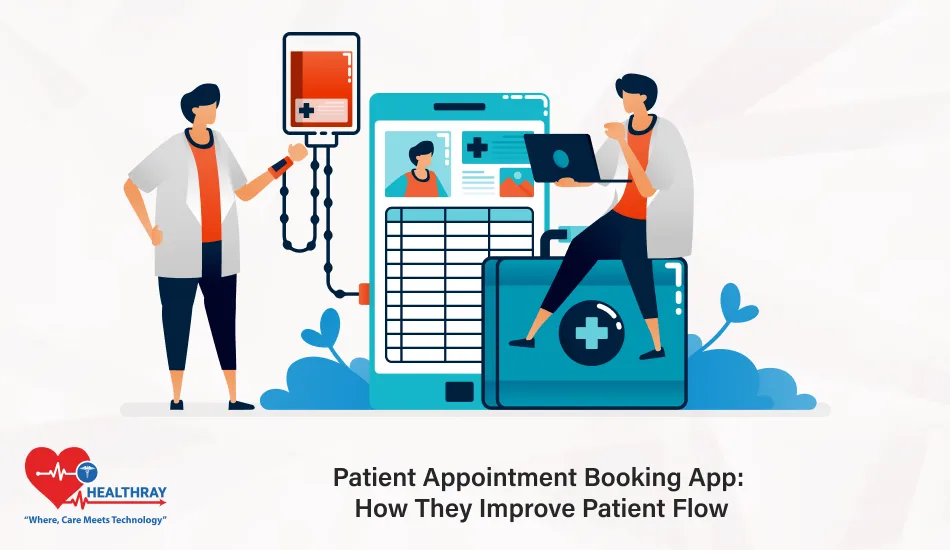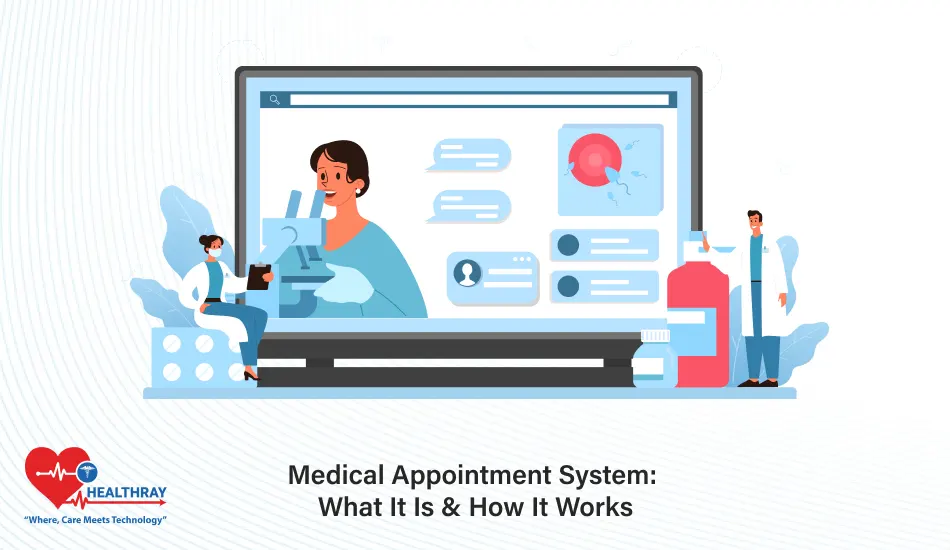Summary
This article explains why a solid legacy EMR replacement strategy is important for all hospitals. It illustrates how legacy systems bog down work, create stress and disrupt patient care. It, too, identifies major risks, including data loss, disruption of workflow, and security gaps.
It then provides concrete action items for planning, implementing and managing the whole replacement process with an appropriate EMR software. Hospitals can successfully transition to a new world where they can enhance day-to-day operations through careful planning, ongoing training, strong vendor support, and regular monitoring.
Introduction
As hospitals expand, existing systems can bog down operations and cause issues. This is why a legacy EMR replacement strategy is so critical. It helps hospitals modernize their systems without losing important data.
First, this strategy teaches how to prepare, execute, and manage risks. Next, it allows staff to quickly adapt to processes. It also enhances daily workflows, all while keeping patient information private.
The right EMR software is also a large part of that success. Hospitals also need to compare options, check features, and match software to their needs. Poor planning can lead to unscheduled delays, cost overruns, and data loss. It is therefore critical for hospitals to have steps in place and involve their staff at the beginning.
In this blog post, we will discuss the risks and practical steps involved in implementing a legacy EMR replacement strategy. By sticking to these tips, hospitals can ensure a seamless and safe transition to a new system, while also advancing patient care and operational efficiencies.
Why a Legacy EMR Replacement Strategy Matters?

Legacy EMR replacement strategy is more important than most realize. In fact, old systems in hospitals make work slow and stressful. There are long lines, tardy reports, and some befuddled staff. Consequently, this all happens because the system cannot keep up.
Therefore, a good plan takes the hospital to new and better equipment without upheaval. Additionally, it also brings modern EMR software that makes work quicker and clearer for everyone.
Consider what that can mean in terms of patient care. For instance, doctors can locate records in seconds. Similarly, nurses can update notes without stressing. As a result, management can easily track reports.
Not only that, modern EMR systems in healthcare help hospitals follow the latest rules. These systems are secure, updated regularly, and protect sensitive data.
Steps to Build an Effective Legacy EMR Replacement Strategy

Here are some steps you can take toward developing a clear and forceful legacy EMR replacement strategy.
Step 1: Conduct a Thorough Deep Check of Your Existing System
First, understand where your old system is failing. For instance, look for slow screens, long loading times, and daily workflow problems. Additionally, watch how often the system crashes. These issues tend to cause stress among doctors, nurses, and administrative teams. Therefore, a clear check helps to fix things for everyone.
Next, compare your current tools with modern EMR software. In doing so, you might spot missing features, displays, or weak security. Since systems have not kept pace with increasing demands, many of the hospitals in India confront these same problems. Consequently, this is a good starting point for you.
Moreover, you should also review EMR systems in healthcare that other hospitals are using today. This comparison helps you see industry standards. You also learn what kind of technology your hospital actually needs. Ultimately, this small step becomes a part of your complete legacy EMR replacement strategy.
Step 2: Set Clear Goals and Success Markers
Once you know your issues, you have to have clear goals. In other words, you decide what success looks like. Specifically, you want faster access to data, less erroneous data, billing that works better, and improved patient flow.
Similarly, the same applies to digital goals. For instance, a mobile EMR app is now used by many hospitals to help facilitate working from anywhere. Therefore, make a decision between mobile access, remote charting, real-time updates, etc. Ultimately, these goals inform your overall legacy EMR replacement strategy.
Next, you should decide how you are going to measure progress. For example, you can track patient wait times, claim approval rates, or time to complete charts. Such stats enable you to see where you need to improve. Furthermore, they let you know if the new EMR software really helps you.
To those of you working in India, it is worth noting that many hospitals prefer locally developed EMR software in India because it caters to existing workflows. Consequently, here is your goal: you build a better plan when the goals align with actual needs.
Step 3: Choose the Right EMR Software for Your Hospital
This is a very important step. Indeed, the EMR systems in healthcare that you will use dictate how you will work going forward. Therefore, it is critical to select the appropriate one. To begin with, first find out whether OPD/IPD, pharmacy, billing, lab, radiology, and emergency care are being handled by the system. In fact, in busy hospitals, these modules can make a big difference.
Next, see how fast pages load in the software. Additionally, consider how fast it can pull up a patient’s information. A smooth operation conserves time and allows doctors and nurses to work with comfort and speed.
In addition, find out whether the vendor has a mobile EMR app for various devices. Mobile devices are increasingly relied on across hospitals for bedside care, ward rounds, and off-site updates. A great mobile app also provides a straightforward and speedy documentation process with less lag time.
Finally, if your hospital is located in India, you would have to look at features specific to EMR software in India. These features include ABHA, e-prescription rules, local languages, OPD, and IPD workflows. Thus, always choose software that understands Indian hospitals.
Step 4: Build a Detailed Data Migration Plan
Data migration is at the core of your legacy EMR replacement strategy. You have to transfer old records to the new system without error. To begin with, make an inventory of all data sets. This could include patient history, lab reports, imaging files, billing records, and prescriptions.
Next, determine what data is useful; in fact, old or duplicate records just complicate things. Therefore, clean your data before you move it. Good data ensures that the new EMR software operates flawlessly.
Furthermore, get your clinical team involved early. Doctors, nurses, and admin staff know what data matters most. Thus, their feedback helps you construct a clear itinerary.
In addition, stage your data migration testing. Specifically, run mini-batches first. This method shows the mistakes early and keeps everything safe.
Step 5: Train Your Staff Early and Keep Training Continuous
It is your staff that determines how well your legacy EMR can be replaced. Therefore, get them training early. Initially, show simple features to your team at the outset. Only go to advanced features later.
Moreover, hire trainers for each department, too. For instance, doctors learn the features they use. Similarly, charting tools are learned by nurses. Meanwhile, admin teams are trained in billing screens. As a result, everyone feels confident if their training relates to their role.
Next, provide practice sessions. Notably, people learn things faster if they try the features themselves. Furthermore, staff also tend to ask good questions in these sessions.
If you have a mobile EMR app, then provide training specific to using the system on mobile devices. Although most staff love mobile tools, they need to learn how to use them safely.
Finally, educate teams about local rules with respect to the use of EMR software in India. This is done to ensure compliance and patient safety.
Step 6: Monitor Performance and Keep Improving
Your business isn’t over once the new system goes live; rather, you have to monitor your own progress. Specifically, you can measure speed, accuracy, and patient experience. You should monitor how staff are using the EMR software.
Second, use reports on the dashboard. In fact, there are good analytics in modern EMR systems in healthcare. The reports identify areas of stagnation and for improvement. Therefore, use them carefully.
If you plan to use a mobile EMR app, then check adoption rates. Moreover, training can be provided if you wish to do so. Although mobile usage tends to increase efficiency, it is crucial to note that this occurs only if there is widespread participation.
Key Risks in Legacy EMR Replacement Strategy
Replacing an old EMR system in healthcare sounds easy, but many hidden risks can quickly disrupt hospital work and patient care.
- Data Migration Errors: Wrong data transfer creates confusion and slows down care.
- Loss of Critical Patient Records: Important patient details may disappear during the shift.
- Workflow Disruption: Daily routines get disturbed and staff struggle to adjust.
- Staff Resistance: Teams resist change when training feels unclear or rushed.
- Security Weaknesses: Hackers target gaps that appear during system transition.
- System Downtime: Hospitals face delays and interruptions during cutover.
- Hidden Costs: Unexpected needs increase total project spending.
- Vendor Issues: Weak vendor support causes long delays and unresolved bugs.
- Integration Problems: Other hospital tools fail to connect smoothly with the new system.
- Unrealistic Timelines: Rushed deadlines increase mistakes and stress.
- Poor Communication: Teams become confused without clear and steady updates.
- No Backup Plan: Work stops suddenly when problems appear without a fallback.
Mitigating Risks in Legacy EMR Replacement Strategy

A strong legacy EMR replacement strategy becomes safe only when you handle risks wisely. So, you must follow clear steps that protect data, support staff, and keep hospital work smooth.
Data Backup, Testing, and Validation
First, you should back everything up before attempting any changes. It protects your hospital from unexpected disasters. And make sure you have several backups in secure places of your EMR software.
Next, test your data regularly. Tests help catch bugs. You can pilot small batches first. It also reduces stress and confusion. Validation becomes very important, too. You have to make sure each file has been moved.
You would review patient records, billing records, reports and prescriptions. These checks enhance trust in the new EMR systems in healthcare. Thorough testing and validation make your legacy EMR replacement strategy far less risky.
Risk Management Frameworks and Contingency Plans
And create a clear risk management plan. This plan lets you know what problems might arise before they surface. You might experience downtime, staff not knowing what to do, or a confusion of data, for example. So write simple steps for handling each one.
Have a solid backup plan in place as well. This backup plan is a safety net. It helps your team to act fast when something breaks. You can switch to a backup server, you can pause the rollout, or you can ring up your vendor on the spot. Those steps stabilize your hospital. A good contingency plan protects both staff and patients during your legacy EMR replacement strategy.
Step towards digital era with our healthcare solution
Revamp your hospital facilities and embrace change for better healthcare management. Ease in managing and organizing large medical datasets leads to effective analysis. Seize the opportunity now!
Vendor Support and Ongoing Maintenance
There is a lot of risk mitigation that your vendor does. Choose a vendor who offers good support and is responsive. Quick assistance eliminates procrastination. Also, the vendor has to guide your team clearly. This support helps everyone to become confident when working with the new EMR software.
Next, the need for ongoing maintenance sets in. With regular updates, your system will be protected from new threats. Updates also increase speed and fix bugs. Good vendors check in regularly via the mobile EMR app and desktop tools. They troubleshoot; they keep things running. Strong vendor support keeps your legacy EMR replacement strategy safe and stable, each day.
Conclusion
To wrap up, a strong legacy EMR replacement strategy enables hospitals to move forward with confidence. It directs every step, mitigates common risks, and facilitates smooth change. Good hospital planning safeguards information, smooths processes and eases the work of employees.
In addition, the right EMR software has the potential of enhancing patient care and the daily operations. It brings speed, security and transparency. With careful planning and steady work, hospitals renew their systems, with replacing old ones without undue stress.
Each baby step makes the transition easier and less dangerous. Ultimately, a savvy legacy EMR replacement strategy makes for a better, more efficient hospital for all.





